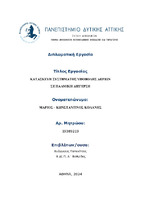| dc.contributor.advisor | Papakitsos, Evangelos | |
| dc.contributor.author | Κολάνης, Μάριος - Κωνσταντίνος | |
| dc.date.accessioned | 2024-04-01T10:37:47Z | |
| dc.date.available | 2024-04-01T10:37:47Z | |
| dc.date.issued | 2024-03-22 | |
| dc.identifier.uri | https://polynoe.lib.uniwa.gr/xmlui/handle/11400/6293 | |
| dc.identifier.uri | http://dx.doi.org/10.26265/polynoe-6129 | |
| dc.description.abstract | Πρόκειται να εξεταστεί ένα σύστημα διατομικών κατά βάση αερίων, που θα εφαρμόζεται σε έναν θάλαμο από μονωτικό υλικό. Το έργο χωρίζεται εξ' ολοκλήρου σε δύο βασικά μέρη - στόχους. Πρωταρχικός σκοπός, ως μηχανικοί, είναι η εύρυθμη απόκριση του συστήματος εκείνου καθώς και η επιλογή κατάλληλων ηλεκτρικών και ηλεκτρονικών μέσων για την επιθυμητή παλμική έξοδο, μέσω της διαμόρφωσης και της σχεδίασης μιας PCB πλακέτας αλλά και κώδικα που να την υποστηρίζει. Το δεύτερο μέρος, αφορά τη κατασκευή του θαλάμου που θα συγκρατεί το ρευστό μέσω προσθετικής κατεργασίας και προετοιμασία του για τη σύνδεση με το πρώτο σκέλος. Περιγραφικά, το αέριο θα εισέρχεται από την κατώτερη οπή του σωληνοειδούς θαλάμου και θα διοχετεύεται σε παλμικό πεδίο που θα βρίσκει χώρο σε μία έκταση της διατομής του. Σκοπός είναι, ο συντονισμός στην ιδιοσυχνότητα ταλάντωσης των μορίων του αερίου, με εκείνη των παλμών των οποίων θα δημιουργούνται και θα εφαρμόζονται σε εκείνο, μέσω διάταξης ηλεκτροδίων που θα εναλλάσσουν την πολικότητα του πεδίου από θετικό σε αρνητικό και αντίστροφα. Έπειτα, θα εξέρχονται τα προϊόντα διάσπασης σε ξεχωριστούς θαλάμους όπου θα φαίνεται και το αποτέλεσμα με εφαρμοσμένες χημικές μεθόδους. Στην ουσία κάνουμε λόγο για μια παραλλαγή της συμβατικής ηλεκτρόλυσης και την απόπειρα ανάπτυξης μιας λύσης από την προσέγγιση ενός μηχανικού. Στο σύνολο αυτού του έργου θα ασχοληθούμε με την υλοποίηση του θαλάμου και τις τεχνικές του, τη συγκέντρωση και τη σύνθεση ηλεκτρονικού υλικού και εξαρτημάτων για τη δημιουργία των επιθυμητών ηλεκτρικών παλμών σε επίπεδο έντασης και συχνότητας και τη μελέτη του συστήματός μας, εφαρμοσμένη με τρόπο που να προβάλλει όλες τις σκοπιές και τους περιορισμούς του. | el |
| dc.format.extent | 63 | el |
| dc.language.iso | el | el |
| dc.publisher | Πανεπιστήμιο Δυτικής Αττικής | el |
| dc.rights | Αναφορά Δημιουργού - Μη Εμπορική Χρήση - Παρόμοια Διανομή 4.0 Διεθνές | * |
| dc.rights | Attribution-NonCommercial-NoDerivatives 4.0 Διεθνές | * |
| dc.rights.uri | http://creativecommons.org/licenses/by-nc-nd/4.0/ | * |
| dc.subject | Παλμική διέγερση | el |
| dc.subject | 3D Printing | el |
| dc.subject | Arduino | el |
| dc.subject | Σχεδιασμός ηλεκτρονικών κυκλωμάτων | el |
| dc.title | Κατασκευή συστήματος υποβολής αεριών σε παλμική διέγερση | el |
| dc.title.alternative | Construction of a system for subjecting gases to pulsing resonance | el |
| dc.type | Διπλωματική εργασία | el |
| dc.contributor.committee | Drosos, Christos | |
| dc.contributor.committee | Laskaris, Nikolaos | |
| dc.contributor.faculty | Σχολή Μηχανικών | el |
| dc.contributor.department | Τμήμα Μηχανικών Βιομηχανικής Σχεδίασης και Παραγωγής | el |
| dc.description.abstracttranslated | In this thesis, a pulsed stimulation system for sectional gas molecules applied to a chamber made of insulating material will be examined. The primary objective of our project, as engineers, is the smooth response of the system in question and the selection of suitable electrical and electronic means for the desired output, such as the design and configuration of a PCB, selection and usage of suitable integrated circuits, controlled by a microcontroller unit such as arduino, and its coding. Of secondary importance and exclusively linked with the chemical engineering field, is the chemical breakdown of the molecules of the representive
gas, with all the benefits that accompany it. Descriptively, the gas will enter through the lower opening of the tubular chamber and will be directed into a pulsed electric field that will occupy an area of its cross-section. The goal is to force the gas molecules resonate at the same frequency of the applied pulsed electric field created. Then, the products of dissociation will exit into separate chambers where the result will be visible with applied chemical methods. Essentially, we are talking about a different approach of conventional electrolysis and the attempt to develop a solution from an engineer's perspective. This thesis as a whole, will deal with the implementation of the chamber and its technical specifications, the collection and composition of electronic material and components for the creation of the desired electrical pulses in terms of intensity and frequency, and the study of our system, applied in a way that highlights all its aspects and limitations. | el |


